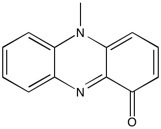Pyocyanin | ROS generator
NMR (Conforms)

Available Options
| size : | Price | Quantity | |
|---|---|---|---|
| 5 mg | $60.00 | ||
| 25 mg | $240.00 |
Pyocyanine (85-66-5), a redox-active phenazine produced by P. aeruginosa and other pathogens, is an electron receptor, which stimulates redox cycling in bacteria as well as in a variety of human cell lines. It enhances oxidative metabolism, which increases the formation of intracellular reactive oxygen species (ROS) via reduction of NADPH. Pyocyanine accelerates neutrophil apoptosis in vitro. Pyocyanine production by P. aeruginosa suppresses the acute inflammatory response by pathogen-driven acceleration of neutrophil apoptosis and associated reduction of local inflammation.
References/Citations:
1) Rada and Leto (2013), Pyocyanin effects on respiratory epithelium: relevance in Pseudomonas Aeruginosa airway infections; Trends Microbiol., 21 73
2) Reszka et al. (2012), Inactivation of the potent Pseudomonas aeruginosa cytotoxin pyocyanin by airway peroxidases and nitrite; Am. J. Physiol. Lung Cell Mol. Physiol., 302 L1044
NMR (Conforms)
Safety Data Sheet:
Product Data Sheet:
Materials provided by Focus Biomolecules are for laboratory research use only and are not intended for human or veterinary applications. Please note that we do not sell to individuals and that all orders placed by non-research organizations will incur a $20 restocking/refund fee
Pyocyanine (85-66-5), a redox-active phenazine produced by P. aeruginosa and other pathogens, is an electron receptor, which stimulates redox cycling in bacteria as well as in a variety of human cell lines. It enhances oxidative metabolism, which increases the formation of intracellular reactive oxygen species (ROS) via reduction of NADPH. Pyocyanine accelerates neutrophil apoptosis in vitro. Pyocyanine production by P. aeruginosa suppresses the acute inflammatory response by pathogen-driven acceleration of neutrophil apoptosis and associated reduction of local inflammation.
References/Citations:
1) Rada and Leto (2013), Pyocyanin effects on respiratory epithelium: relevance in Pseudomonas Aeruginosa airway infections; Trends Microbiol., 21 73
2) Reszka et al. (2012), Inactivation of the potent Pseudomonas aeruginosa cytotoxin pyocyanin by airway peroxidases and nitrite; Am. J. Physiol. Lung Cell Mol. Physiol., 302 L1044
Calculate the molar concentration, mass or volume in a solution.
Concentration × Volume × Molecular Weight = Mass
Focus Biomolecules • Plymouth Meeting, PA USA • 1-855-FOCUS21
Focus Biomolecules
Plymouth Meeting, PA USA
1-855-FOCUS21
Website Created by Advanta Advertising LLC.

